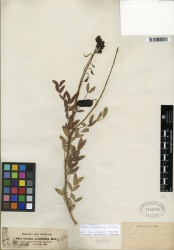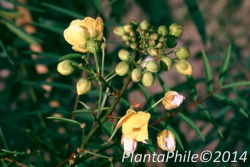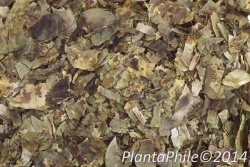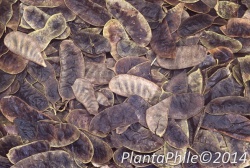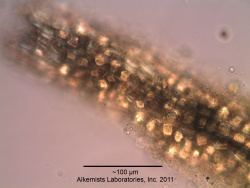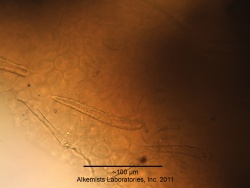Senna alexandrina (leaf)
(add USD 1918 information (macroscopic)) |
(add PlantaPhile references) |
||
| Line 34: | Line 34: | ||
''Cassia angustifolia,'' as usually grown is annual, but with care it may be made to live through the year, and then assumes the character of an undershrub. It has an erect, smooth stem, and pinnate leaves, with from four to eight pairs of leaflets. These are nearly sessile, lanceolate, obscurely mucronate, oblique at the base, smooth above and somewhat downy beneath, with the veins turned inward so as to form a wavy line immediately within the edge of the leaflet. The most striking character of the leaflet is its length, which varies from 2 to 5 cm. The petioles are without glands; the stipules minute, spreading and semi-hastate. The flowers are bright yellow, and arranged in axillary and terminal racemes rather longer than the leaves. The legume is oblong, membranous, tapering abruptly at the base, rounded at the summit, and 4 to 5 cm. long by about 1.5 cm. broad. }} | ''Cassia angustifolia,'' as usually grown is annual, but with care it may be made to live through the year, and then assumes the character of an undershrub. It has an erect, smooth stem, and pinnate leaves, with from four to eight pairs of leaflets. These are nearly sessile, lanceolate, obscurely mucronate, oblique at the base, smooth above and somewhat downy beneath, with the veins turned inward so as to form a wavy line immediately within the edge of the leaflet. The most striking character of the leaflet is its length, which varies from 2 to 5 cm. The petioles are without glands; the stipules minute, spreading and semi-hastate. The flowers are bright yellow, and arranged in axillary and terminal racemes rather longer than the leaves. The legume is oblong, membranous, tapering abruptly at the base, rounded at the summit, and 4 to 5 cm. long by about 1.5 cm. broad. }} | ||
| + | {{ Media3 | cat=Macroscopy | ||
| + | | source=PlantaPhile | ||
| + | | mainimage=PlantaPhile - 567.jpg | ||
| + | | companyimage=PlantaPhile logo.jpg | ||
| + | | companyURL=http://plantaphile.com/ | ||
| + | |||
| + | | source2=PlantaPhile | ||
| + | | image2=PlantaPhile - 1793.jpg | ||
| + | | companyimage2=PlantaPhile logo.jpg | ||
| + | | companyURL2=http://plantaphile.com/ | ||
| + | |||
| + | | source3=PlantaPhile | ||
| + | | image3=PlantaPhile - 1820.jpg | ||
| + | | companyimage3=PlantaPhile logo.jpg | ||
| + | | companyURL3=http://plantaphile.com/ | ||
| + | | }} | ||
|} | |} | ||
Revision as of 18:14, 28 April 2015
Contents |
Nomenclature
Senna alexandrina Mill. Fabaceae
Syn. Cassia acutifolia Delile; Cassia angustifolia Vahl; Cassia lanceolata Forssk.; Cassia senna L.; Senna acutifolia (Delile) Batka; Senna angustifolia (Vahl) Batka
Standardized common name (English): senna
Ayurvedic name(s): svarnapatri
Pinyin name(s): xia ye fan xie; jian ye fan xie; fan xie ye (leaf)
Botanical Voucher Specimen
|
|
Organoleptic Characteristics
Macroscopic Characteristics
|
Microscopic Characteristics
 |
 |
|
|
|
High Performance Thin Layer Chromatographic Identification
Supplementary Information
Sources
- ↑ MOBOT, Tropicos.org http://www.tropicos.org/Image/100192283
- ↑ United States Dispensatory (1918)
- ↑ PlantaPhile http://plantaphile.com/
- ↑ PlantaPhile http://plantaphile.com/
- ↑ PlantaPhile http://plantaphile.com/
- ↑ Elan M. Sudberg, Alkemist Laboratories http://www.alkemist.com
- ↑ Elan M. Sudberg, Alkemist Laboratories http://www.alkemist.com
